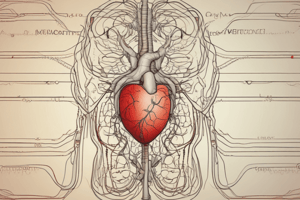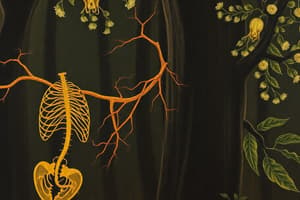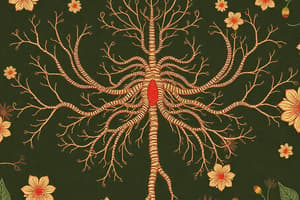Podcast
Questions and Answers
Which cranial nerve is responsible for increasing the power of the lens and accommodation to near vision?
Which cranial nerve is responsible for increasing the power of the lens and accommodation to near vision?
- Cranial Nerve III (correct)
- Cranial Nerve VII
- Cranial Nerve X
- Cranial Nerve IX
Which nerve contains 75% of all the parasympathetic nerve fibers in the body?
Which nerve contains 75% of all the parasympathetic nerve fibers in the body?
- Cranial Nerve VII
- Cranial Nerve X (correct)
- Cranial Nerve IX
- Cranial Nerve III
Which nerve is responsible for contraction of the wall of the bladder and relaxation of the internal urethral sphincter?
Which nerve is responsible for contraction of the wall of the bladder and relaxation of the internal urethral sphincter?
- Cranial Nerve X
- Cranial Nerve III
- Cranial Nerve VII
- The Pelvic Nerve (correct)
Which nerve supplies the submaxillary and sublingual salivary glands, tongue, nasopharynx, and lacrimal glands?
Which nerve supplies the submaxillary and sublingual salivary glands, tongue, nasopharynx, and lacrimal glands?
Which nerve is responsible for stimulation of bronchial mucus secretion and coronary vasoconstriction?
Which nerve is responsible for stimulation of bronchial mucus secretion and coronary vasoconstriction?
Where do the parasympathetic nerves arise from?
Where do the parasympathetic nerves arise from?
Where do the parasympathetic nerves relay in terminal ganglia?
Where do the parasympathetic nerves relay in terminal ganglia?
What is the distribution of the parasympathetic nervous system?
What is the distribution of the parasympathetic nervous system?
What is the relationship between the functions of sympathetic and parasympathetic supply?
What is the relationship between the functions of sympathetic and parasympathetic supply?
Why are not all components of the parasympathetic system activated at one time?
Why are not all components of the parasympathetic system activated at one time?
Study Notes
Cranial Nerves and Their Functions
- The oculomotor nerve (CN III) is responsible for increasing the power of the lens and allowing accommodation for near vision.
- The vagus nerve (CN X) contains approximately 75% of all parasympathetic nerve fibers in the body, playing a crucial role in autonomic functions.
- The pelvic splanchnic nerves are responsible for contraction of the bladder wall and relaxation of the internal urethral sphincter for urination.
- The facial nerve (CN VII) supplies the submaxillary and sublingual salivary glands, as well as the tongue, nasopharynx, and lacrimal glands.
Additional Cranial Nerve Functions
- The vagus nerve (CN X) also stimulates bronchial mucus secretion and induces coronary vasoconstriction.
Origin and Relay of Parasympathetic Nerves
- Parasympathetic nerves arise from the brainstem and sacral spinal cord (S2-S4), signifying their craniosacral origin.
- These nerves relay in terminal ganglia that are located close to or within the target organs, allowing for localized control.
Distribution and Functionality of the Parasympathetic Nervous System
- The parasympathetic nervous system distributes its fibers to various organs, generally promoting rest and digest activities.
- The functions of the sympathetic and parasympathetic systems are complementary; while the sympathetic system prepares the body for 'fight or flight', the parasympathetic system promotes 'rest and digest'.
Coordination of Parasympathetic Responses
- Not all components of the parasympathetic system are activated simultaneously to maintain balance and prevent conflicting signals that could disrupt autonomic functions.
Studying That Suits You
Use AI to generate personalized quizzes and flashcards to suit your learning preferences.
Description
This quiz covers the functions of the parasympathetic nervous system and the chemical transmission in the autonomic nervous system (ANS), including the types of receptors involved. It also delves into the origins of parasympathetic nerves from distinct parts of the central nervous system.




